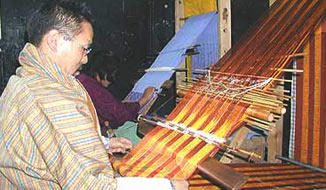| Bhutan
- The Land of Weaving and Textiles |
| Bhutan's
Textile Industry |
 |
Bhutan Economy |
|
 |
Bhutan Information |
|
|
 |
|
Kelzang
Lhundrup, one of Bhutan's few men weavers
|
 |
| Kelzang Lhundrup |
| Strapped
to the loom among a row of women weavers, eyes focusing intensely and fingers
working nimbly on some silk motifs, Kelzang Lhundrup cuts a rather odd
picture. Even in the land of weaving and textiles, a man at the loom is
not a common sight. The 43-year old, however, feels pretty much at home
at the loom where he has woven thousands of kiras and ghos in a career
spanning 35 years. |
|
One
of Bhutan's few men weavers and designers and perhaps the most recognized,
Kelzang he 'secretly picked up' weaving from his grandmother who raised
him and who had 'quite a reputation for her weaving skills' in Bartsham,
a prosperous Trashigang village.
|
Keeping
Bhutan's textile tradition alive
|
"I
started fiddling around with yarn when I was about six years," Kelzang
recalls fondly. "By seven I was getting into the loom whenever my grandmother
went on some errands or worked in the field." He also "listened with breath
held tight in his chest" when she taught a "thoroughly disinterested" cousin.
He started weaving clothes that "could be worn" from the age of eight.
At 14 he was selected by his gup to attend a year-long training at the
handloom development center in Khaling. He was the only boy among 13 girls
and, to make the distinction even wider, he topped the group. There has
been no looking back since then.
Today
his clientele will surely make it to Bhutan's who's who. He lists members
of the royal family, cabinet ministers, senior bureaucrats and their aums,
and the business elite among his up-market customers. And for someone who
has not even studied the alphabet, he has done well.
| Gagyel
Lhundrup weaving centre |
Kelzang
Lhundrup owns Gagyel Lhundrup weaving centre, perhaps Bhutan's first commercial
textile weaving centre using the backstrap loom, which employs around 20
weavers. The centre sells kiras and ghos woven from terri-cotton as well
as those from pure silk.
Silk
kiras and ghos, which are generally custom-made, range from Nu. 7,500 to
80,000. The terri-cotton ones, in which the centre does a roaring business,
range from Nu. 1,200 to 4,500. He has bigger plans for the future. He wants
to open a showroom that will sell ensembles of hand-woven women's and men's
wear designed by him.
Kelzang's
focus and primary interest areas are pesar kiras and ghos. He says designing
pesar clothes gives him artistic satisfaction since there is no limit to
the range and variety of designs. "Imagination is the only limit," says
Kelzang, who picks up design ideas from nature, such as flowers, and imported
attires and fabrics besides improvising traditional designs. "Pesar clothes
are a rage in the market today. Everybody wants and wears pesar."
Kelzang
capped his three and a half decade career by winning the Nu 50,000 prize
for best pesar design in the national design competition this year. He
had missed the title last year when he managed only a third position although
he had won the second prize for traditional design."This is the crowning
glory of my career," he beams. Although many Bhutanese would frown upon
the idea of men taking up weaving, Kelzang feels that men weavers are not
ostracized."At least I haven't encountered any resentment," he says. "People
want to wear my clothes and I am proud of what I do."
This
passion is also shared by Kelzang's two elder daughters who assist him
when they are not preoccupied with a different brand of designing of their
own. The two sisters, who won for best 'innovative design' last year and
claimed the second prize this year, are into modern 'western style' fashion
designing and have begun a range of clothing called 'Bhutanity'. "The traditional
and western blend creates absolutely stunning wear," says Kelzang excitedly,
convinced that there "definitely" is an export market if "designs were
done well and correctly". He in fact plans to send his daughters to study
fashion designing.
Kelzang,
who "cannot imagine making a living any other way", wants to do "whatever
he can" to keep Bhutan's textile tradition alive. "It is a totally unique
art," he says. "May be I am too emotionally attached but I feel there is
no equal to our weaving and textiles. Our kiras and ghos are the best dresses
in the world. I want to go on making them look even more appealing and
beautiful till the day I die."
| This
article was contributed by KUENSEL, Bhutan's National Newspaper |
 |
| Information on Bhutan |
 |
|



